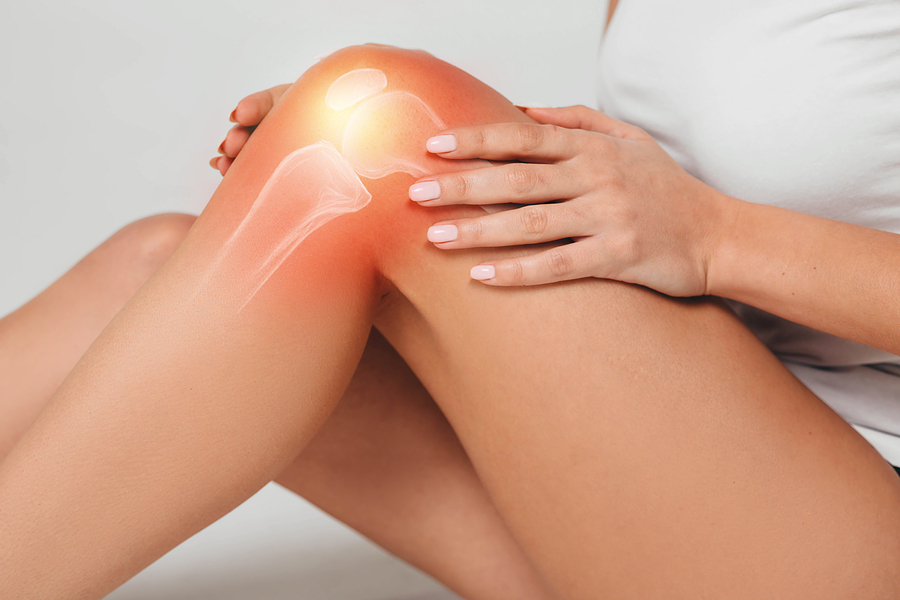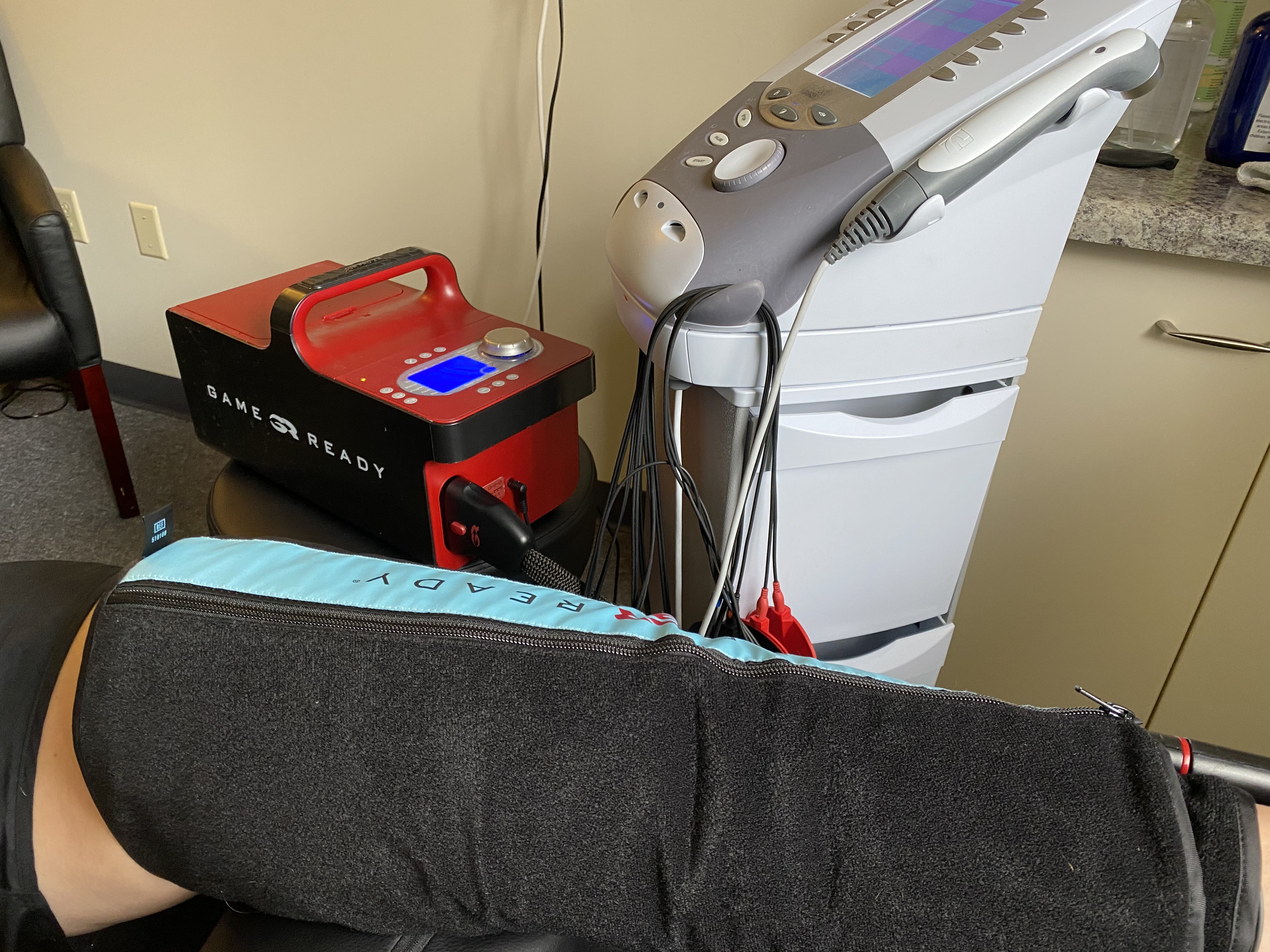Chondromalacia patella is deep pain in the knee. It could be dull, sharp or achy. It is the softening and breakdown of the soft tissue cartilage under the patella. Pain is from the nerves getting pinched or irritated between the patella and femur/tibia. It is common to here crackling or a grinding sound when flexing or extending the knee.

What is chondromalacia patella?
Chondromalacia patella is from the pressure or rubbing of your knee cap or patella on the bones under the knee. This breaks down the cartilage so that there is less lubrication to allow the knee to function smoothly. The pain is from the nerves becoming irritated because of the lack of space and the increase in pressure. The creaking that you are hearing is from bad dysfunctional cartilage or bone on bone grinding.
Who is at risk for chondromalacia patella?
People who are at risk for developing chondromalacia patella include:
- Overweight population
- Patients with flat feet
- Jumping, running or climbing on hard surfaces.
- Females slightly more because of knee angle
- Patients with Patella-Femoral Syndrome
SYMPTOMS AND CAUSES
What causes chondromalacia patella?
Chondromalacia patella is usually from the overuse or misuse the cartilage under the patella. Chronic inflammation or irritation will cause the degeneration of the cartilage and decreased function of that tissue. The body will start to compensate from knee pain by flattening arch and increasing the use of your glut medius and TFL (muscle for IT band). This will then not allow for the patella to slide properly within the joint which will irritated the side that is rubbing more than it should. Pain is from the irritation of the nerves within the joint from increase friction and pressure.
What are the symptoms of chondromalacia patella?
Dull achy or sharp pin anywhere surrounding patella or deep in knee during…
- Repetitive weightbearing activity – Kneeling and flexing knees past 90 degrees
- Pain can also be noticed after laying down after activities that irritate.
- Running – Slowing down or running downhill will irritate
- Stairs – Worse going down
Abnormal noise in knee when flexing and extending:
- Creaking
- Crackling
- Feeling of sand under patella
- Crepitus
DIAGNOSIS
How to diagnose chondromalacia patella?
A doctor will perform a neurologic, muscular and orthopedic examination of the knee to determine the cause of pain. Diagnosis can be confirmed with:
- Blood test to determine if body is inflamed or has underlying condition.
- MRI is the best test to see soft tissue and cartilage.
- Arthroscopy can see with a camera inside the knee to determine extent of damage of cartilage.
TREATMENT
How to treat chondromalacia patella?
The best way to treat chondromalacia patella is get a diagnosis and treatment from a trained professional. Treatment utilized incorrectly can cause increased damage and inflammation.

BEST AND MOST EFFECTIVE TREATMENT
- Chiropractic and Physical Therapy: Guided plan to progressively heal the body with no set backs. Reprogramming muscle firing patterns, aligning joints and strengthen muscles so that the body can function properly.
- Ice compression with a game ready can be very effective to decrease inflammation.
- Electrical stimulation can help to reactivate muscles, increase blood flow, decrease spasm, and lower pain.
- Adjustments can help effectively increase full joint range of motion.
- Postural correction to direct pressure through the center of your joints.
- Strengthening and balancing muscles – To effectively control and utilize joint to limit wear and tear.
- Custom inserts and shoes – To help support natural arch which will align knee and hips and absorb shock.
- Exercises – Progress through exercises as body needs to improve firing patterns so that joints function properly.
- Weight loss – If overweight it is imperative to decrease the load on your joints to limit irritation and allow joints to heal.
COMMON TREATMENT
- Decreasing inflammation with ice and compression recommended by trained professional
- Nonsteroidal anti-inflammatory drugs (NSAIDs) to reduce pain which should also be directed by a medical professional. These should only be short term as they mask pain, they do not solve underlying proplem
- Topical pain reducers – This is also to distract you from pain and does not correct the problem causing pain.
- Prescription pain relievers – These are stronger masking drugs. This may allow you to function but they are also for short term relief. Long term use may cause nasty side effects.
- Injections – These are more of a last resort and work to decrease inflammation and repair directly at joint site. They can also be diagnostic to see if this is where pain is actually occurring.
- Surgery – This is to clean up or repair joint surgically. Risk of infection or scar tissue can result from surgery. If pain is too extensive and other modalities have failed then this may be the only option.
PROGNOSIS
What is the prognosis for chondromalacia patella?
Patients recover from chondromalacia patella better when they are younger and when symptoms are caught early. Ignoring chronic knee pain or not getting treatment can lead to arthritis. Children still growing will come out of this when they reach adulthood but should still seek treatment and diagnosis. The longer you wait, the less likely you will have a good prognosis.
Written and Edited by
Dr. Michael Veerman
Owner – MVP Chiropractic and Physical Therapy


